西班牙习俗英文介绍
- 格式:ppt
- 大小:30.47 MB
- 文档页数:30
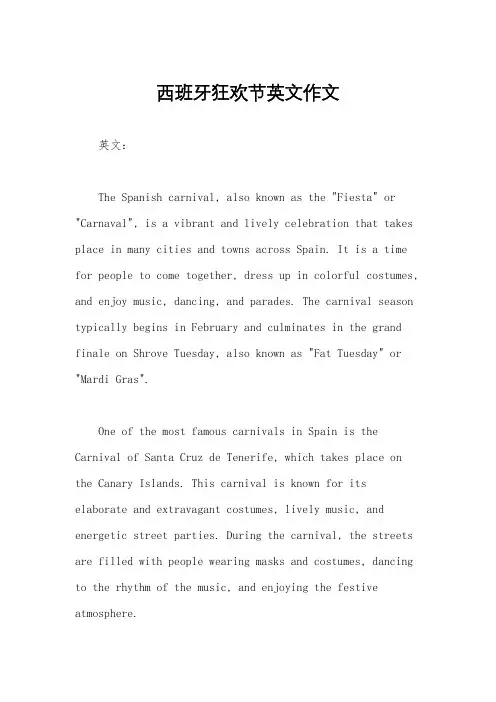
西班牙狂欢节英文作文英文:The Spanish carnival, also known as the "Fiesta" or "Carnaval", is a vibrant and lively celebration that takes place in many cities and towns across Spain. It is a time for people to come together, dress up in colorful costumes, and enjoy music, dancing, and parades. The carnival season typically begins in February and culminates in the grand finale on Shrove Tuesday, also known as "Fat Tuesday" or "Mardi Gras".One of the most famous carnivals in Spain is the Carnival of Santa Cruz de Tenerife, which takes place on the Canary Islands. This carnival is known for its elaborate and extravagant costumes, lively music, and energetic street parties. During the carnival, the streets are filled with people wearing masks and costumes, dancing to the rhythm of the music, and enjoying the festive atmosphere.In addition to the lively street parties, the Spanish carnival also features colorful parades with floats, dancers, and performers. These parades often have aspecific theme and showcase the creativity and artistry of the participants. One of the highlights of the parades is the election of the carnival queen, who is chosen for her beauty, charisma, and ability to represent the spirit of the carnival.Another important aspect of the Spanish carnival is the tradition of "burial of the sardine", which symbolizes the end of the carnival season and the beginning of Lent. This symbolic ritual involves a mock funeral procession for a sardine, followed by the burning of a large sardine effigy. It is a lighthearted and humorous way to bid farewell to the festivities and prepare for the solemnity of Lent.Overall, the Spanish carnival is a time of joy, creativity, and community spirit. It is a celebration that brings people together to embrace their cultural heritage, express themselves through music and dance, and createlasting memories with friends and family.中文:西班牙狂欢节,也被称为“Fiesta”或“Carnaval”,是西班牙许多城市和小镇上的一个充满活力和热闹的庆祝活动。

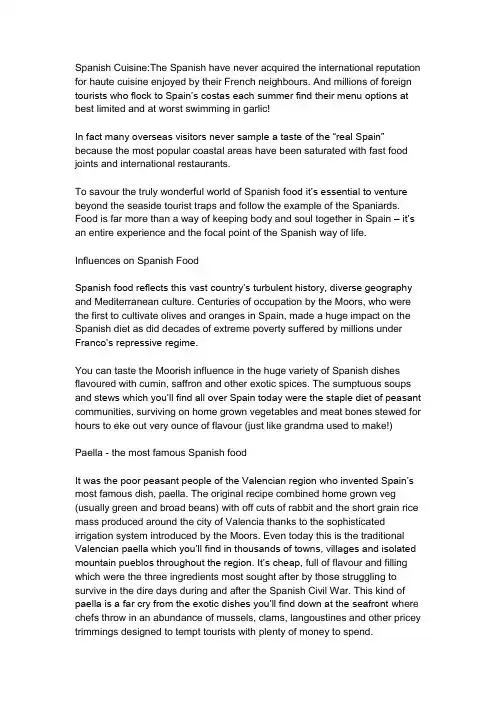
Spanish Cuisine:The Spanish have never acquired the international reputation for haute cuisine enjoyed by their French neighbours. And millions of foreign tourists who flock to Spain’s costas each summer find their menu options at best limited and at worst swimming in garlic!In fact many overseas visitors never sample a taste of the “real Spain” because the most popular coastal areas have been saturated with fast food joints and international restaurants.To savour the truly wonderful world of Spanish fo od it’s essential to venture beyond the seaside tourist traps and follow the example of the Spaniards. Food is far more than a way of keeping body and soul together in Spain –it’s an entire experience and the focal point of the Spanish way of life.Influences on Spanish FoodSpanish food reflects this vast country’s turbulent history, diverse geography and Mediterranean culture. Centuries of occupation by the Moors, who were the first to cultivate olives and oranges in Spain, made a huge impact on the Spanish diet as did decades of extreme poverty suffered by millions under Franco’s repressive regime.You can taste the Moorish influence in the huge variety of Spanish dishes flavoured with cumin, saffron and other exotic spices. The sumptuous soups and st ews which you’ll find all over Spain today were the staple diet of peasant communities, surviving on home grown vegetables and meat bones stewed for hours to eke out very ounce of flavour (just like grandma used to make!)Paella - the most famous Spanish foodIt was the poor peasant people of the Valencian region who invented Spain’s most famous dish, paella. The original recipe combined home grown veg (usually green and broad beans) with off cuts of rabbit and the short grain rice mass produced around the city of Valencia thanks to the sophisticated irrigation system introduced by the Moors. Even today this is the traditional Valencian paella which you’ll find in thousands of towns, villages and isolated mountain pueblos throughout the region. It’s cheap, full of flavour and filling which were the three ingredients most sought after by those struggling to survive in the dire days during and after the Spanish Civil War. This kind of paella is a far cry from the exotic dishes you’ll find down at the seafront where chefs throw in an abundance of mussels, clams, langoustines and other pricey trimmings designed to tempt tourists with plenty of money to spend.No matter where you are in Spain, as a general rule of thumb you’ll get tastier food for far less money if you eat where the Spanish eat and follow them along to the street markets which are a treasure trove of fresh, cheap and high quality local produce.Spain is the second largest country in western Europe and there are many regional variations in terms of the local cuisine. But the national diet is characterised by a reliance on olive oil for cooking and flavouring and a passion for all kinds of fish. Spanish workmen eat octopus washed down with a brandy or glass of red wine for breakfast and toddlers happily tuck into a plate of snails or clams at any time of day (can you imagine a British kid?!)Food in AndaluciaThe Costa del Sol is famed for its grilled sardines, barbecued on the beach in the summer months, whilst wider Andalucia brought us Gazpacho (chilled tomato soup) and the delightful habit of serving tapas with every drink. Traditionally a tapa, which means cover in Spanish, was served free with a drink – maybe a morsel of dried ham, manchego cheese or tortilla. The snack was placed on the small plate used to cover the drink to keep away flies. In most tourist centres these days you have to pay for your tapas but they’re still served free in many inland areas of Andalucia and elsewhere around the country.Galicia, in the north west corner of Spain, is the place to visit for some of the finest fresh fish in the world. And in many regions where the numbers of pigs and sheep outnumber people, you’ll find a heavy reliance on pork and lamb dishes. Pork is the most widely eaten meat in Spain – partly because the Moors refused to eat it so cooking with pork became almost a part of the Christian religion!An exciting way of exploring Spanish food and wine is through culinary tours in Spain. You can find all sorts of them, from wine tasting in Rioja to tapas tours in cities like Madrid and Barcelona, as well as cooking lessons in emblematic places and olive oil or serrano ham routes.Choose an area in Spain to read more about different types of spanish food酒管09314小组,。

众所周知,我们我国是一个礼仪之邦,西班牙作为一个历史悠久的欧洲国家,同样也拥有很多的礼仪习俗,那今天我们就来了解一下吧!1.问好礼仪(Etiqueta de saludo)与我国人的含蓄内敛不同,西班牙是个热情奔放的民族,所以他们的性格体现在了他们的肢体语言上。
良久没见的朋友或亲人一定要来个紧紧的长期的大拥抱,快乐之余很可能会有激动的眼泪。
假如是第一次他人介绍知道,男女之间或女女之间要拥抱外加两个脸颊的beso,男男之间则是握手,我们要自我介绍而且表明很快乐知道你之类的话。
2.餐桌礼仪(Etiqueta de la mesa)西班牙人在用餐的时分和西方国家相同使用刀叉,都是右手持刀,左手拿叉。
在吃饭的时分,双手要摆放在桌子上,不能放到桌子下面,否则就会被视作不礼貌的行为。
在赴宴的时分,位子的分配也是有讲究的,主人右侧的位子不能随意坐,只要主客才能坐在那里,女主人不能坐在男主人边上,而要坐在桌子的另一边。
在用餐的时分,尽可能吃光食物,这也是对主人的一种尊重。
另外在就餐的时分,一般男人们和女人们不会交织着坐在一同,而是男人们坐在一边,女人们坐在另一边。
在用餐完毕之后,假如在饭馆的话,要付给侍者小费(Propina),一般消费的数目是消费数目的10%,另外西班牙吃饭时间与我国吃饭时间比较有很大差异。
早餐时间一般在7:00-8:00之间,午餐时间一般在13:00—15:30 之间,晚餐时间一般在20:30—23:00之间。
3.商务礼仪(Etiqueta de negocios)西班牙人很注重诺言,总是尽可能地实行签定的合同,即使后来发现合同中有对他们不利的当地,他们也不肯揭露供认自己的过错。
如在这种情况下,对方能够好心地帮助他们,则会赢得西班牙人的尊重与友谊。
西班牙人只要在参与斗牛比赛活动时才严守时间,但客人应当守时,即使对方晚到,也不要加以责怪。
留意:在西班牙,不要对斗牛活动有谴责,假如你对情况不了解,最好不要对斗牛活动发表任何定见。
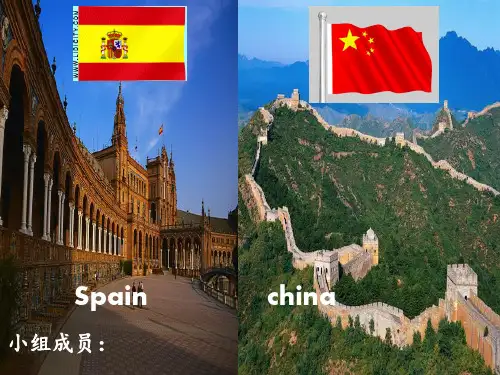
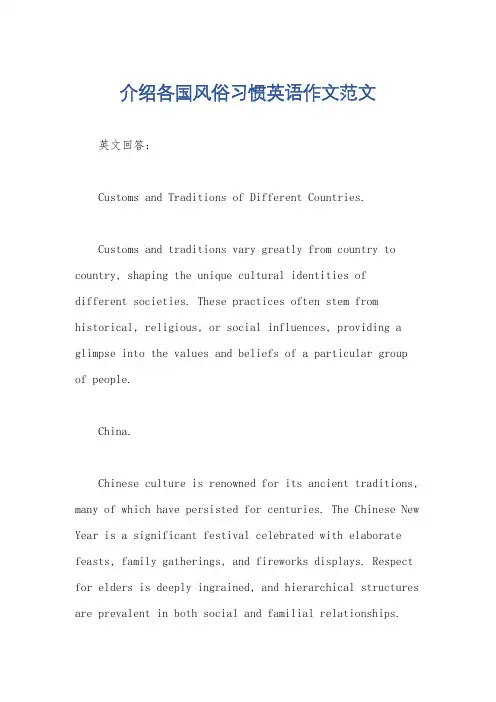
介绍各国风俗习惯英语作文范文英文回答:Customs and Traditions of Different Countries.Customs and traditions vary greatly from country to country, shaping the unique cultural identities ofdifferent societies. These practices often stem from historical, religious, or social influences, providing a glimpse into the values and beliefs of a particular group of people.China.Chinese culture is renowned for its ancient traditions, many of which have persisted for centuries. The Chinese New Year is a significant festival celebrated with elaborate feasts, family gatherings, and fireworks displays. Respect for elders is deeply ingrained, and hierarchical structures are prevalent in both social and familial relationships.Japan.Japan is a nation known for its intricate customs and etiquette. The tea ceremony, or chanoyu, is an ancient ritual that embodies Japanese aesthetics and hospitality. Respect for nature is evident in the traditional art of ikebana, or flower arranging, and the practice of shinto, the indigenous religion.India.India is a vibrant tapestry of diverse cultures, each with its own unique customs and traditions. The caste system, a social hierarchy based on birth, has been a defining feature of Indian society for centuries. The practice of yoga and meditation originated in India, and the country's rich religious heritage includes Hinduism, Buddhism, and Sikhism.Mexico.Mexican culture is a vibrant blend of indigenous and Spanish influences. The Day of the Dead, or Día de los Muertos, is a unique festival that celebrates the lives of deceased loved ones with colorful parades, music, and food offerings. The Mexican dance style of mariachi is anintegral part of the country's cultural identity.France.France is renowned for its sophisticated culture and culinary traditions. The French language is known for its elegance and precision, and the country's art, fashion, and architecture have had a profound influence on Western civilization. The French Revolution, a pivotal event in world history, played a significant role in shaping the nation's modern customs and values.Italy.Italian culture is characterized by its passion, warmth, and love of food. Family plays a central role in Italian society, and meals are often elaborate and communal affairs.The rich history of Italy is evident in its ancient ruins, Renaissance masterpieces, and the thriving traditions of opera and theater.Brazil.Brazil is a vibrant and diverse nation with unique customs and traditions. Carnival, a pre-Lenten festival, is celebrated with colorful costumes, elaborate parades, and samba dancing. The indigenous culture of Brazil has left a lasting legacy in the country's music, dance, andtraditional crafts.Cultural Exchange and Understanding.Customs and traditions are an integral part of human society, reflecting the diversity and richness of our cultures. By learning about and respecting different customs, we can foster cultural exchange, promote understanding, and build bridges between people of diverse backgrounds.中文回答:各国风俗习惯。
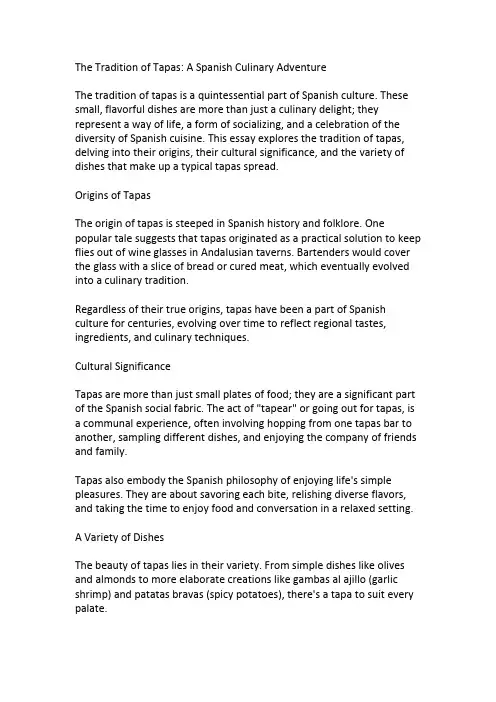
The Tradition of Tapas:A Spanish Culinary AdventureThe tradition of tapas is a quintessential part of Spanish culture.These small,flavorful dishes are more than just a culinary delight;they represent a way of life,a form of socializing,and a celebration of the diversity of Spanish cuisine.This essay explores the tradition of tapas, delving into their origins,their cultural significance,and the variety of dishes that make up a typical tapas spread.Origins of TapasThe origin of tapas is steeped in Spanish history and folklore.One popular tale suggests that tapas originated as a practical solution to keep flies out of wine glasses in Andalusian taverns.Bartenders would cover the glass with a slice of bread or cured meat,which eventually evolved into a culinary tradition.Regardless of their true origins,tapas have been a part of Spanish culture for centuries,evolving over time to reflect regional tastes, ingredients,and culinary techniques.Cultural SignificanceTapas are more than just small plates of food;they are a significant part of the Spanish social fabric.The act of"tapear"or going out for tapas,is a communal experience,often involving hopping from one tapas bar to another,sampling different dishes,and enjoying the company of friends and family.Tapas also embody the Spanish philosophy of enjoying life's simple pleasures.They are about savoring each bite,relishing diverse flavors, and taking the time to enjoy food and conversation in a relaxed setting.A Variety of DishesThe beauty of tapas lies in their variety.From simple dishes like olives and almonds to more elaborate creations like gambas al ajillo(garlic shrimp)and patatas bravas(spicy potatoes),there's a tapa to suit every palate.Seafood tapas are a staple in coastal regions,featuring dishes like pulpo a la gallega(Galician-style octopus)or boquerones en vinagre(anchovies marinated in vinegar).Inland,you'll find tapas featuring cured meats, cheeses,and regional specialties.Vegetable-based tapas,like pimientos de padrón(fried green peppers) or espárragos blancos(white asparagus),showcase Spain's seasonal produce,while montaditos,small sandwiches topped with a variety of ingredients,demonstrate the creativity and versatility inherent in tapas. ConclusionIn conclusion,the tradition of tapas is a delightful culinary adventure that offers a taste of Spain's rich culture and cuisine.It's a tradition that celebrates diversity,encourages social interaction,and elevates simple ingredients into flavorful bites of joy.Whether you're enjoying tapas in a bustling Spanish mercado or preparing a tapas feast at home,remember that it's not just about the food-it's about the experience,the people, and the pleasure of sharing good food and good times.。


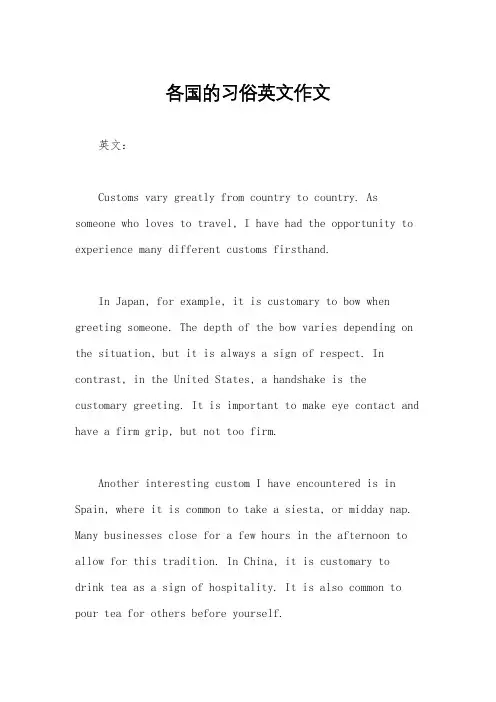
各国的习俗英文作文英文:Customs vary greatly from country to country. As someone who loves to travel, I have had the opportunity to experience many different customs firsthand.In Japan, for example, it is customary to bow when greeting someone. The depth of the bow varies depending on the situation, but it is always a sign of respect. In contrast, in the United States, a handshake is the customary greeting. It is important to make eye contact and have a firm grip, but not too firm.Another interesting custom I have encountered is in Spain, where it is common to take a siesta, or midday nap. Many businesses close for a few hours in the afternoon to allow for this tradition. In China, it is customary to drink tea as a sign of hospitality. It is also common to pour tea for others before yourself.In my own country, the Philippines, there are many customs that are unique to our culture. One example is the tradition of mano po, where younger people show respect to their elders by taking their hand and placing it on their forehead. It is also customary to remove one's shoes before entering someone's home.Overall, customs are an important part of a country's culture and should be respected when traveling. By learning and understanding these customs, we can better appreciate and connect with the people and their way of life.中文:习俗因国而异。
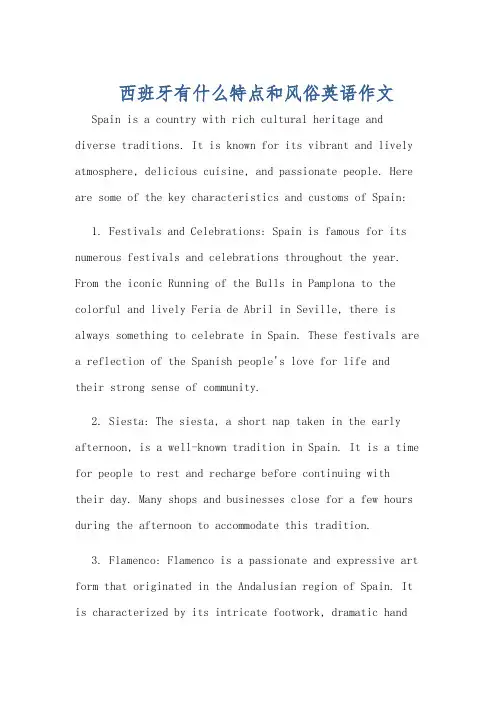
西班牙有什么特点和风俗英语作文Spain is a country with rich cultural heritage and diverse traditions. It is known for its vibrant and lively atmosphere, delicious cuisine, and passionate people. Here are some of the key characteristics and customs of Spain:1. Festivals and Celebrations: Spain is famous for its numerous festivals and celebrations throughout the year. From the iconic Running of the Bulls in Pamplona to the colorful and lively Feria de Abril in Seville, there is always something to celebrate in Spain. These festivals are a reflection of the Spanish people's love for life andtheir strong sense of community.2. Siesta: The siesta, a short nap taken in the early afternoon, is a well-known tradition in Spain. It is a time for people to rest and recharge before continuing withtheir day. Many shops and businesses close for a few hours during the afternoon to accommodate this tradition.3. Flamenco: Flamenco is a passionate and expressive art form that originated in the Andalusian region of Spain. It is characterized by its intricate footwork, dramatic handmovements, and soulful music. Flamenco is an integral partof Spanish culture and is often performed at festivals, weddings, and other special occasions.4. Tapas and Paella: Spanish cuisine is world-renownedfor its delicious and diverse flavors. Tapas, small platesof appetizers and snacks, are a popular way to enjoy a variety of dishes in one sitting. Paella, a traditional Spanish rice dish, is also a staple of Spanish cuisine andis often enjoyed with family and friends during gatherings.5. Bullfighting: Bullfighting is a controversialtradition in Spain that has been a part of the country's culture for centuries. While it has faced criticism in recent years, it remains a significant cultural event for many Spaniards.6. Religious Festivals: Spain is a predominantlyCatholic country, and religious festivals play asignificant role in Spanish culture. Semana Santa, or Holy Week, is a particularly important religious festival thatis celebrated with processions, music, and traditional food.7. Soccer: Soccer, or football as it is known in Spain,is a passion for many people in the country. The Spanishnational team has a strong following, and the country is home to several world-renowned soccer clubs, such as Real Madrid and FC Barcelona.These are just a few of the many traditions and customs that make Spain a unique and fascinating country.西班牙是一个拥有丰富文化遗产和多样传统的国家。
西班牙有什么特点和风俗英语作文Spain is a captivating country that boasts a rich cultural heritage, vibrant traditions, and a diverse landscape. From the sun-drenched beaches of the Balearic Islands to the majestic Pyrenees mountains, Spain offers a captivating blend of history, art, and gastronomy that enchants visitors from around the world.One of the most striking features of Spain is its regional diversity. Each autonomous community within the country has its own distinct identity, language, and customs, creating a tapestry of cultural riches. In the northern region of Catalonia, the Catalan language and traditions thrive, with iconic landmarks like the Sagrada Familia in Barcelona and the medieval towns of Girona. Further south, Andalusia is renowned for its Moorish influence, exemplified by the stunning Alhambra palace in Granada and the flamenco dance that originated in this region.The Spanish way of life is centered around the concept of "convivencia," which emphasizes the importance of shared experiences and social connections. This is evident in the country's vibrant outdoor culture, where locals and visitors alike gather in plazas, cafes, and tapas bars to savor the local cuisine and engage inlively conversations. The tradition of the "siesta," a midday break for rest and relaxation, is deeply ingrained in the Spanish psyche, reflecting the country's laid-back and unhurried approach to life.One of the most captivating aspects of Spanish culture is its rich artistic heritage. From the surreal masterpieces of Pablo Picasso and Salvador Dalí to the architectural wonders of Antoni Gaudí, Spain has long been a hub of artistic innovation and creativity. The country's museums, such as the Prado in Madrid and the Guggenheim in Bilbao, showcase the works of these and other renowned artists, offering visitors a glimpse into the country's cultural legacy.The Spanish culinary landscape is equally impressive, with each region boasting its own unique specialties and flavors. Tapas, a tradition of small shared plates, has become a global phenomenon, with Spanish restaurants around the world serving up delectable bites like jamón ibérico, patatas bravas, and tortilla española. The country's wine regions, such as Rioja and Ribera del Duero, produce world-class vintages that have earned global acclaim.Beyond its cultural riches, Spain is also renowned for its natural beauty. The Balearic Islands, with their crystal-clear waters and white-sand beaches, offer a tropical escape, while the rugged landscapes of the Pyrenees and the Picos de Europa mountain ranges provide ample opportunities for outdoor adventures. The Canary Islands,situated off the northwest coast of Africa, are a popular destination for their volcanic landscapes and year-round mild climate.In conclusion, Spain is a country that captivates the senses and leaves a lasting impression on all who visit. From its vibrant regional cultures and artistic heritage to its delectable cuisine and breathtaking natural landscapes, Spain offers a truly unique and unforgettable experience. Whether you're exploring the winding streets of Seville, indulging in a tapas crawl in Madrid, or hiking through the stunning Pyrenees, there is always something new to discover in this enchanting land.。
西班牙新年英语作文简短Title: Celebrating New Year in Spain。
New Year's Eve in Spain is a vibrant and festive occasion marked by various traditions and customs. As the clock strikes midnight, the streets come alive with joyous celebrations, symbolizing hopes for a prosperous and fulfilling year ahead.One of the most prominent traditions in Spain during New Year's Eve is the consumption of twelve grapes. As each bell tolls at midnight, it is customary for people to eat one grape, making a wish with each one consumed. This tradition, known as "Las doce uvas de la suerte" (The twelve grapes of luck), is believed to bring good fortune for the twelve months of the coming year. It's a fun and lighthearted tradition that brings people together to usher in the New Year with optimism and hope.In addition to eating grapes, another popular traditionis wearing red underwear on New Year's Eve. It is believed that wearing red underwear will bring good luck and love in the coming year. As a result, many people make it a pointto purchase new red underwear specifically for this occasion, ensuring they start the year off on the right foot.Fireworks displays are also a common sight across Spain on New Year's Eve. From bustling city centers to quaint villages, the sky lights up with dazzling colors asfireworks illuminate the night. The fireworks symbolize joy and celebration, creating a festive atmosphere that resonates with people of all ages.Furthermore, many Spaniards attend special New Year's Eve parties or gatherings with family and friends. These gatherings often feature delicious traditional foods, such as seafood, cured meats, and sweets like turron (a type of nougat) and polvorones (shortbread cookies). Music, dancing, and laughter fill the air as people come together to bid farewell to the old year and welcome the new one with open arms.As the night progresses, the streets remain alive with revelry well into the early hours of the morning. People continue to celebrate in bars, clubs, and public squares, sharing toasts and exchanging well-wishes for the New Year. It's a time of camaraderie and unity, as communities come together to embrace the spirit of renewal and new beginnings.Overall, New Year's Eve in Spain is a time of joy, tradition, and celebration. From the eating of grapes to the wearing of red underwear, each custom and tradition adds to the rich tapestry of the holiday season. As the clock strikes midnight and the New Year dawns, Spaniards across the country come together to welcome thepossibilities of the future while cherishing the memories of the past.。
西班牙新年英语作文简短Title: Celebrating New Year in Spain。
New Year's Eve in Spain is a lively and vibrant celebration filled with traditions and customs that bring people together to welcome the upcoming year. From bustling city streets to quaint village squares, the spirit of joy and anticipation fills the air as Spaniards bid farewell to the old year and embrace the new.One of the most iconic traditions in Spain is the tradition of eating twelve grapes at midnight. As the clock strikes twelve, people across the country gather with their families and friends to consume twelve grapes, one for each chime of the clock. It is believed that this ritual brings good luck and prosperity for the twelve months ahead. The grapes must be eaten quickly and without hesitation, a task that can prove to be quite challenging but adds to the fun and excitement of the evening.Another important aspect of New Year's celebrations in Spain is the tradition of wearing red underwear. It is believed that wearing red underwear on New Year's Eve brings good luck and fortune for the coming year. As a result, lingerie shops across the country are bustling with customers in the days leading up to the holiday, eager to purchase their lucky red undergarments.In addition to these traditions, many cities and towns across Spain host lively street parties and fireworks displays to ring in the New Year with style. From the bustling streets of Madrid to the picturesque beaches of Barcelona, people gather to dance, sing, and celebrate well into the early hours of the morning.For those looking for a more traditional celebration, attending a New Year's Eve mass at one of Spain's beautiful churches is a popular choice. Many churches hold special midnight masses to give thanks for the blessings of the past year and to seek guidance and blessings for the year ahead.Overall, New Year's Eve in Spain is a time of joy, celebration, and hope for the future. Whether you're enjoying grapes with loved ones, donning your lucky red underwear, or dancing in the streets, the spirit of camaraderie and optimism is palpable as Spaniards welcome the arrival of the new year with open arms.。
英文介绍西班牙圣诞节的作文One of the most important events during the Spanish Christmas season is the Feast of Immaculate Conception on December 8th. This national holiday marks the official start of the Christmas season. Many families attend church services and honor the Virgin Mary on this day. It is also the day when the Christmas lights are turned on in cities and towns across the country, creating a magical atmosphere.Another notable aspect of the Spanish Christmas celebrations is the nativity scene, or "Belen". Every Spanish household, church, and public space has a carefully crafted Belen representing the birth of Jesus. These intricate dioramas often include not only the traditional Holy Family, but also various characters from local folklore and daily life. The Belen can be as small as a tabletop display or as large as a life-sized scene, attracting visitors from far and wide.One of the most famous nativity scenes in Spain is found in Barcelona's Plaza de Sant Jaume. It spans over 1,000 square meters and features more than 150 life-sized figures. Known as "El Pessebre de la Plaça", this Belen transports visitors to the streets of Bethlehem, complete with moss-covered hills, flowing rivers, and realistic market stalls. It is a must-visit attraction for both locals and tourists during the holiday season.As Christmas draws near, the festive spirit intensifies with various events and traditions. On December 21st, the city of Barcelona hosts the "Dia de los Santos Inocentes" (Day of the Holy Innocents), similar to April Fool's Day in other countries. Friends and family play tricks on each other and newspapers publish fake news stories, creating a lighthearted and humorous atmosphere.However, the most eagerly awaited celebration is undoubtedly Nochebuena, or Christmas Eve, on December 24th. Families come together to enjoy a sumptuous meal, often featuring traditional dishes like roast turkey, suckling pig, and seafood. The most famous Christmas dessert in Spain is "turrón", a nougat made with almonds, honey, and egg white. It comes in a variety of flavors and is enjoyed by all ages.After the meal, families attend the Misa del Gallo, or Midnight Mass, to celebrate the birth of Jesus. Churches are filled with beautiful Christmas carols and the atmosphere is filled with love, peace, and joy. This religious ceremony is an important tradition in Spain, symbolizing the true meaning of Christmas.On Christmas Day, families continue their celebrations by exchanging gifts and spending time together. Many Spaniards also participate in the Spanish Christmas Lottery, known as "El Gordo" (The Fat One). It is the world's largest lottery, with prizes totaling billions of euros. The draw, held on December 22nd, is accompanied by a festive atmosphere and excited anticipation.The holiday season in Spain officially concludes on January 6th with the celebration of Epiphany, or "Dia de los Reyes" (Day of the Kings). Children eagerly await the arrival of theThree Wise Men who bring them gifts. The night before, parades are held in cities and towns across Spain, featuring colorful floats and performers tossing sweets to the crowd. It is a magical experience for children and a fitting end to the Christmas season.In conclusion, the Spanish Christmas traditions are rich in history, culture, and religious significance. From the elaborate nativity scenes to the festive parades, Spain offers a unique and unforgettable Christmas experience. Whether you are a local or a visitor, celebrating Christmas in Spain is a joyous and memorable occasion that brings families and communities together to celebrate love, peace, and the spirit of the season.。
西班牙奔牛节英文作文The Running of the Bulls is a traditional festival held in Pamplona, Spain, every year in July. It involves a group of bulls running through the streets of the city, while people try to outrun them. This festival is a major attraction for tourists from all over the world.The festival has a long history and is deeply rooted in Spanish culture. It is believed to have originated in the 14th century, when farmers would run in front of the bulls to take them to the bullring. Over time, the tradition evolved into a festival that attracts thousands of people every year.The festival is not without controversy, however. Animal rights activists have long criticized the event, arguing that it is cruel to the bulls. In recent years, there have been calls to ban the festival altogether. Despite this, the festival continues to be a major event in Spain, and many people argue that it is an importantcultural tradition.The festival is not just about running with the bulls, however. There are also parades, music, and dancing, as well as plenty of food and drink. The atmosphere in Pamplona during the festival is electric, with people from all over the world coming together to celebrate.For those who do decide to run with the bulls, it is important to remember that it is a dangerous activity. Every year, there are injuries and even deaths as a result of the festival. It is important to take the necessary precautions and to be aware of the risks involved.Overall, the Running of the Bulls is a unique and exciting festival that is deeply ingrained in Spanish culture. While it may not be for everyone, it is certainly an experience that those who participate will never forget.。
The eating habits of SpainSpain is famous for many things: Bull, olive trees, Picasso, flamenco Branch's songs. Oh » Also, the garlic flavor Piaoman the country. There is no doubt that Spain's most famous dishes is the "Para", which is a pot of the Crocus Yiman, rice, shrimp, Gebeng, chicken and a spicy Spanish sausage and peas in the United States and meals. "Para" from Spain and Chek Cephalonia language in the "Jianguo", usually with an iron Zhedao Cai boiling pans, eating the same time as the family banquet, a bit like the United States Louisiana Taste dishes.Below Spain to take a look at the more delicious on the table:Galician broth: a whole pot of potatoes, green cabbage, Baidou and meat stew or ham from the system, most of the Galician coast of Spain welcomed. Spain green soup: a Daguo potatoes, Baidou, vegetables and sausage stew very thick soup. Meat pies: from the fermentation of a bag of meat, spinach, sausage, squid, shrimp and vegetables make the stuffing, made of. Fruit pie: the most popular desserts, a butter cake, aromatic and pleasant. Spanish cold soup: vegetables, tomatoes, vinegar and a little pepper make a cold summer soup, and quilts as "liquid salad." Sometimes soup is still above the addition of some films, such as cucumber, as a decoration.Galician soup materials used: 1 tablespoon olive oil, 1 onion, chopped, 4 cups water, 2 cups small white potatoes, garlic 2-3 flap, Paisui; twomedium-large carrot, to Piqie Ding; salt 1 / 2 teaspoon; pepper 1 / 2 teaspoon; broken turnip or mustard Green Green 1 / 2 teaspoon; Baiyun beans 1 can (15 ounces), controlling water; Netherlands fresh chopped celery 1 / 4 cupSystem of law: take the pot hot oil, Add to onions and garlic, fried 4 minutes, add water, potatoes, radish and dry materials. Fire in 20-25 minutes, occasionally Fandong. Add to Luobu Ding, Yundou and the Netherlands-qin, and then burned five minutes. Fire Commissioner of the rice for 10 minutes. To make soup even some thick, can be used spoon in the pot back wall of the crowded potatoes broken. Chuguo bowl loaded with crispy bread to eat.Grilled squid salad materials: one pounds of fresh squid, cleaned; olive oil 1 / 2 cup; garlic 6-8 flap, Paisui; chopped fresh parsley 2-3 spoons; lemon juice (from 1 Lemon squeezed out), black pepper 1 / 2 teaspoon; salt 1 / 2 teaspoon; colored leaves or leaf lettuce 1, Wash; two tomatoes, chopped to nuclear; one red onion, cut long; 1 cucumber, sliced; Suanla sand Division 1 / 2 cup System of law: the oil, garlic, parsley, lemon juice and seasonings Add to bowl Leveling Draw Frame. Add to squid again, and then placed in the refrigerator 2-3 hours. The lettuce, tomato, onion, cucumber and Suanla sand Secretary Bancheng salad. Preheat oven, burning of carbon-wang, Grill Oiler. Squid will be removed from the pickle juice, on the Grill, bake 5-7 minutes each side, until the roast is Shutou. Kaohao remove the squid, placed on the salad can be consumed.。